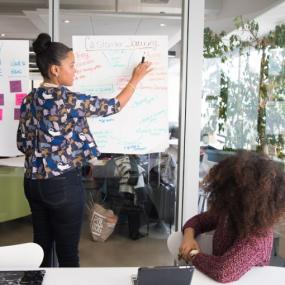It's important for not-for-profits to have an online communications plan. Taking some time at the start to map out your efforts will help you know what you’re trying to achieve, provide enough to maintain your presence and measure its effectiveness. This template will help you target your communications to specific audiences and also tie your activities back to your organisation’s goals. It’s a useful way to map out your tasks and actions as well as seeing how they relate back to the final result.
Target Audiences
First, we need to identify who we’re communicating with. For most organisations, they key audiences will be:
- existing clients
- potential new clients
- government bodies
- staff.
You can also take it further by specifying demographics or types of clients.
For each of your target audiences, it’s important to understand what you’re trying to communicate to them. One way to do this is to identify:
- what your goals are for each audience (e.g. improved communication, higher retention for existing clients and increasing the intake of new clients)
- what their needs are and how you will meet them
- your key messages relating to each goal.
Here’s an example of a disability service that offers a LEGO Club for children under 14. Their group recreation service offers one hour sessions for up to six children with one staff member, and one of their main audiences will be the parents of the children. They may also have other audiences such as corporate sponsors, donors or other potential partners. For each of these audiences, a new row could be added. These would then be included in the communications plan below.
|
Audience |
Our goals |
What we offer them that they want |
Key message |
|---|---|---|---|
|
Parents of children |
Have a full roster of children |
Quality, small group play under NDIS |
We understand your needs and your child's love of LEGO |
Communications Plan
Once you have defined your audiences and your goals for them, it’s time to start planning how you’re going to achieve those goals. You can do this by using a framework with:
- Goals – identified in the previous step, your overarching campaign goals.
- Objectives – these are measurable milestones that you need to achieve to reach your goal.
- Strategies – identifying different components needed to hit those milestones (objectives).
- Tactics – specific tasks that could also be allocated to team members that need completion.
Creating SMART objectives
Measurement is important. It means that you’ll be able to refine and adapt your efforts and know if you’re on par with where you need to be. One common way of doing this is by using the “SMART” system which stands for “Specific, Measurable, Achievable, Relevant and Timely”.
It’s important that your objectives are clear (specific), able to be measured, that you have the skills and time to achieve them, that they’re relevant to your goals and that you have a time by which you want to achieve them.
An example may be: “A 30% increase in new clients from surrounding suburbs within 3 months.”
Strategies and tactics
Your strategies are the different components needed to achieve your objective. When it comes to communication, you could also look at strategies as the communications channel you are going to use (e.g. blog, newsletter, social media etc).
From our example, we’ll look at one target audience and show how we map out our objectives, strategies and tactics. We’ll also include a due date for our tactics to help us understand what needs to be done.
Pulling it all together
Here’s an example of how your goals, objectives, strategies and tactics can be planned out to support your online communications.
Target Audience: Parents of children under 14 interested in LEGO
|
Goals |
Objectives |
Strategies |
Tactics |
|---|---|---|---|
|
Add 100 new weekly clients to LEGO Club sessions |
Have 300 requests for more information (new clients) |
Provide fliers to community groups |
Print fliers for parent groups |
|
Contact local community groups and drop off fliers |
|||
|
Create referral program for friends of current clients |
Create landing page on website for referral program |
||
|
Send email to current clients |
|||
|
Create five case studies from current clients |
Publish case studies online |
||
|
Publish case studies in hard-copy |
|||
|
Share LEGO related stories on Facebook once per week |
Source Facebook links |
||
|
Schedule Facebook links |
|||
|
Share photos of creations on Facebook once per week |
Take photos during sessions |
||
|
Get permissions from parents if needed |
|||
|
Schedule photos on Facebook |
|||
|
Have 100 families complete the online registration form for weekly sessions online |
Review website with focus on sign up registrations |
Work with designer to update website |
|
|
Review website for search engine optimisation |
Work with SEO (Search Engine Optimisation) agency to update SEO |
||
|
Highlight benefits of weekly sessions online |
Create blog post on weekly benefits |
||
|
Promote blog post on social media |
|||
|
Offer discount for choosing weekly sessions |
Update pricing on website with new deal |
||
|
Offer special deal to families who are not currently signed on as weekly attendees. |
Email families |
||
|
Contact via phone |
This process would then be repeated for every target audience until a full communications plan is laid out. Tasks could also be assigned dates and allocated to team members to perform. Depending on how your team is managing the whole project or campaign, the tasks and due dates could be entered into a separate project management tool for collaboration.
What’s next?
Now that you have created your communications plan, it’s time to put it into action! If you haven’t already created your website, it’s a good place to start. If you already have a website, it’s a chance to review how you’re using it and to make any changes you need so you can achieve your goals.
Learn more
Watch a webinar recording on how to be found online and attract your community.





Status message
Thanks for rating this guide.